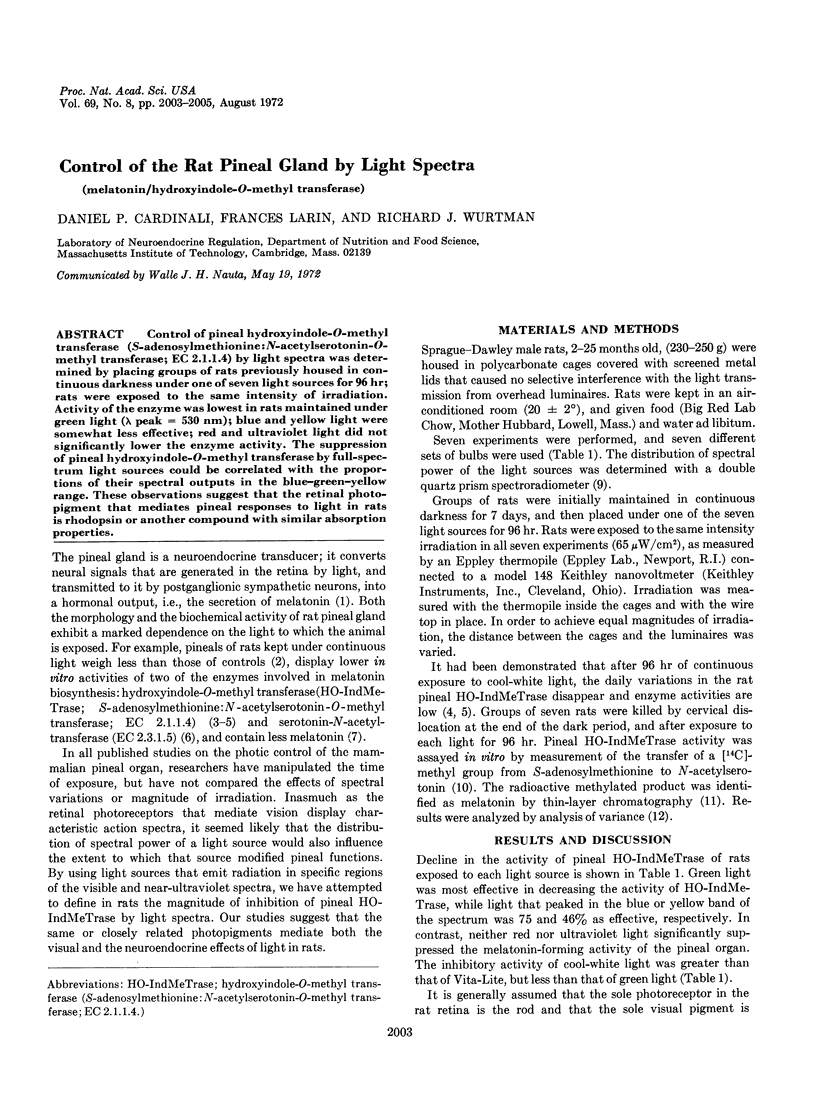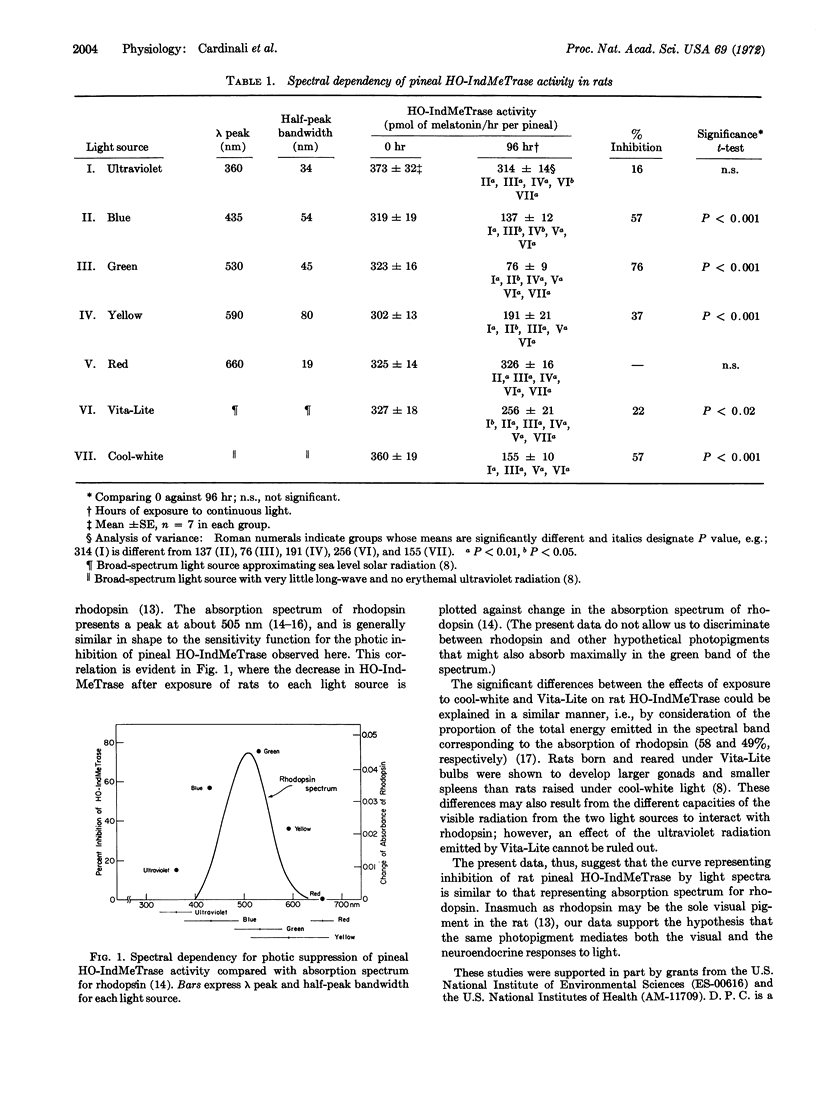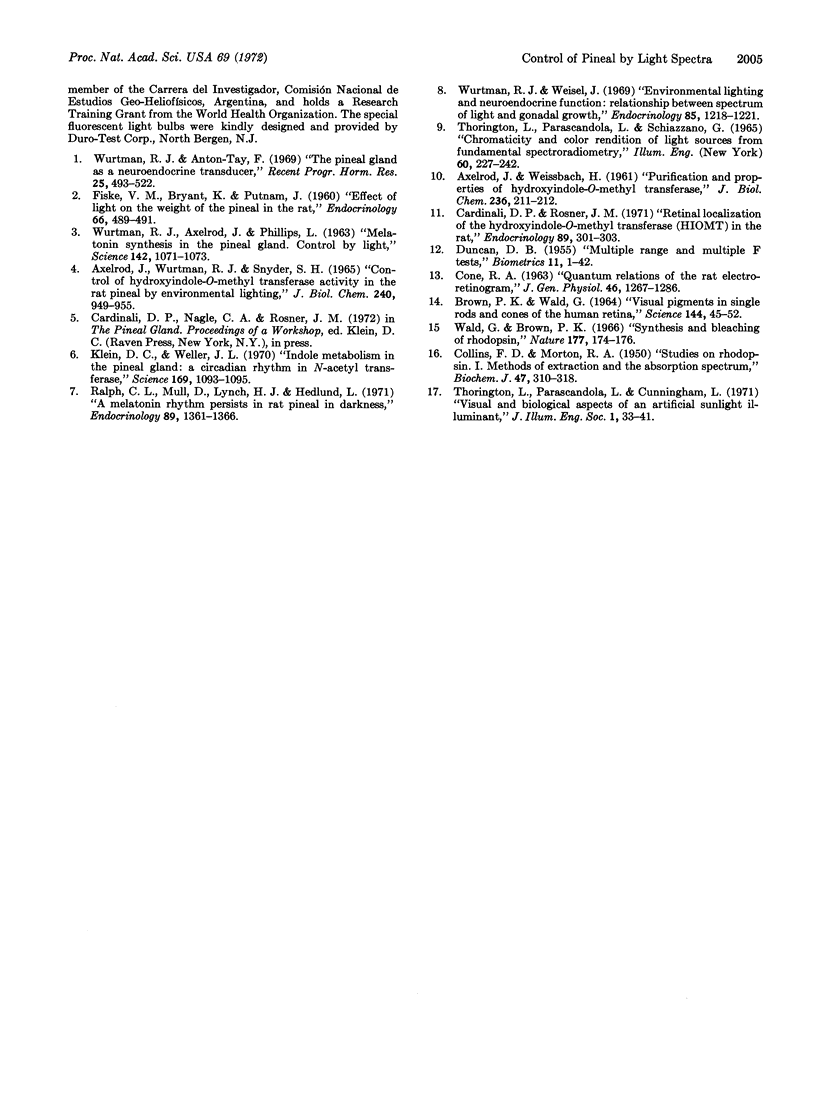Abstract
Control of pineal hydroxyindole-O-methyl transferase (S-adenosylmethionine:N-acetylserotonin-O-methyl transferase; EC 2.1.1.4) by light spectra was determined by placing groups of rats previously housed in continuous darkness under one of seven light sources for 96 hr; rats were exposed to the same intensity of irradiation. Activity of the enzyme was lowest in rats maintained under green light (λ peak = 530 nm); blue and yellow light were somewhat less effective; red and ultraviolet light did not significantly lower the enzyme activity. The suppression of pineal hydroxyindole-O-methyl transferase by full-spectrum light sources could be correlated with the proportions of their spectral outputs in the blue-green-yellow range. These observations suggest that the retinal photopigment that mediates pineal responses to light in rats is rhodopsin or another compound with similar absorption properties.
Keywords: melatonin, hydroxyindole-O-methyl transferase
Full text
PDF


Selected References
These references are in PubMed. This may not be the complete list of references from this article.
- AXELROD J., WEISSBACH H. Purification and properties of hydroxyindole-O-methyl transferase. J Biol Chem. 1961 Jan;236:211–213. [PubMed] [Google Scholar]
- AXELROD J., WURTMAN R. J., SNYDER S. H. CONTROL OF HYDROXYINDOLE O-METHYLTRANSFERASE ACTIVITY IN THE RAT PINEAL GLAND BY ENVIRONMENTAL LIGHTING. J Biol Chem. 1965 Feb;240:949–954. [PubMed] [Google Scholar]
- BROWN P. K., WALD G. VISUAL PIGMENTS IN SINGLE RODS AND CONES OF THE HUMAN RETINA. DIRECT MEASUREMENTS REVEAL MECHANISMS OF HUMAN NIGHT AND COLOR VISION. Science. 1964 Apr 3;144(3614):45–52. doi: 10.1126/science.144.3614.45. [DOI] [PubMed] [Google Scholar]
- CONE R. A. QUANTUM RELATIONS OF THE RAT ELECTRORETINOGRAM. J Gen Physiol. 1963 Jul;46:1267–1286. doi: 10.1085/jgp.46.6.1267. [DOI] [PMC free article] [PubMed] [Google Scholar]
- Cardinali D. P., Rosner J. M. Retinal localization of the hydroxyindole-O-methyl transferase (HIOMT) in the rat. Endocrinology. 1971 Jul;89(1):301–303. doi: 10.1210/endo-89-1-301. [DOI] [PubMed] [Google Scholar]
- Klein D. C., Weller J. L. Indole metabolism in the pineal gland: a circadian rhythm in N-acetyltransferase. Science. 1970 Sep 11;169(3950):1093–1095. doi: 10.1126/science.169.3950.1093. [DOI] [PubMed] [Google Scholar]
- Ralph C. L., Mull D., Lynch H. J., Hedlund L. A melatonin rhythm persists in rat pineals in darkness. Endocrinology. 1971 Dec;89(6):1361–1366. doi: 10.1210/endo-89-6-1361. [DOI] [PubMed] [Google Scholar]
- WALD G., BROWN P. K. Synthesis and bleaching of rhodopsin. Nature. 1956 Jan 28;177(4500):174–176. doi: 10.1038/177174a0. [DOI] [PubMed] [Google Scholar]
- WURTMAN R. J., AXELROD J., PHILLIPS L. S. MELATONIN SYNTHESIS IN THE PINEAL GLAND: CONTROL BY LIGHT. Science. 1963 Nov 22;142(3595):1071–1073. doi: 10.1126/science.142.3595.1071. [DOI] [PubMed] [Google Scholar]
- Wurtman R. J., Anton-Tay F. The mammalian pineal as a neuroendocrine transducer. Recent Prog Horm Res. 1969;25:493–522. doi: 10.1016/b978-0-12-571125-8.50014-4. [DOI] [PubMed] [Google Scholar]
- Wurtman R. J., Weisel J. Environmental lighting and neuroendocrine function: relationship between spectrum of light source and gonadal growth. Endocrinology. 1969 Dec;85(6):1218–1221. doi: 10.1210/endo-85-6-1218. [DOI] [PubMed] [Google Scholar]


